Sep 4, 2023
Atomic Habit #2

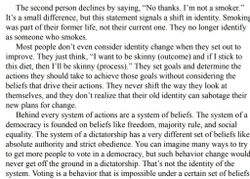
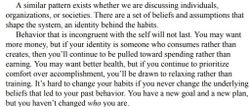
Glossary:
Shift: change
Sabotage: destroy/damage
Vice versa: The other way around
Incongruent: not suitable or not fitting well with something else
Hassle: inconvenient
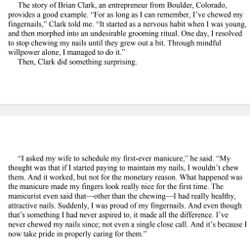

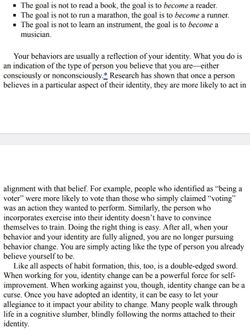
Glossary:
Cognitive slumber is when the mind does not actively analyze and grade the quality of it's person's identity as evidenced by the behaviors and actions the mind sees this person doing.
allegiance: Loyalty from subordinate to superior in a group.
incorporate: join/combine
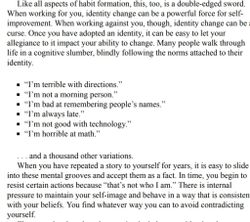
The more deeply a thought or action is tied to your identity, the more
difficult it is to change it. It can feel comfortable to believe what your
culture believes (group identity) or to do what upholds your self-image
(personal identity), even if it’s wrong. The biggest barrier to positive change
at any level—individual, team, society—is identity conflict. Good habits
can make rational sense, but if they conflict with your identity, you will fail
to put them into action.
On any given day, you may struggle with your habits because you’re too
busy or too tired or too overwhelmed or hundreds of other reasons. Over the
long run, however, the real reason you fail to stick with habits is that your
self-image gets in the way. This is why you can’t get too attached to one
version of your identity. Progress requires unlearning. Becoming the best
version of yourself requires you to continuously edit your beliefs, and to
upgrade and expand your identity.
This brings us to an important question: If your beliefs and worldview
play such an important role in your behavior, where do they come from in
the first place? How, exactly, is your identity formed? And how can you
emphasize new aspects of your identity that serve you and gradually erase
the pieces that hinder you?
THE TWO-STEP PROCESS TO CHANGING YOUR IDENTITY
Your identity emerges out of your habits. You are not born with preset
beliefs. Every belief, including those about yourself, is learned and conditioned through experience.* More precisely, your habits are how you embody your identity. When you make your bed each day, you embody the identity of an organized person. When you write each day, you embody the identity of a creative
person. When you train each day, you embody the identity of an athletic person. The more you repeat a behavior, the more you reinforce the identity associated with that behavior. In fact, the word identity was originally derived from the Latin words essentitas, which means being, and identidem,
which means repeatedly. Your identity is literally your “repeated
beingness.”
Whatever your identity is right now, you only believe it because you have proof of it. If you go to church every Sunday for twenty years, you have evidence that you are religious. If you study biology for one hour every night, you have evidence that you are studious. If you go to the gym even when it’s snowing, you have evidence that you are committed to fitness. The more evidence you have for a belief, the more strongly you will believe it.
For most of my early life, I didn’t consider myself a writer. If you were to ask any of my high school teachers or college professors, they would tell you I was an average writer at best: certainly not a standout. When I began my writing career, I published a new article every Monday and Thursday
for the first few years. As the evidence grew, so did my identity as a writer. I didn’t start out as a writer. I became one through my habits.
Of course, your habits are not the only actions that influence your identity, but by virtue of their frequency they are usually the most important ones. Each experience in life modifies your self-image, but it’s unlikely you would consider yourself a soccer player because you kicked a ball once or
an artist because you scribbled a picture. As you repeat these actions, however, the evidence accumulates and your self-image begins to change. The effect of one-off experiences tends to fade away while the effect of
habits gets reinforced with time, which means your habits contribute most of the evidence that shapes your identity. In this way, the process of building habits is actually the process of becoming yourself.
Each habit not only gets results but also teaches you something far more
important: to trust yourself. You start to believe you can actually
accomplish these things. When the votes mount up and the evidence begins
to change, the story you tell yourself begins to change as well.
Of course, it works the opposite way, too. Every time you choose to
perform a bad habit, it’s a vote for that identity. The good news is that you
don’t need to be perfect. In any election, there are going to be votes for both
sides. You don’t need a unanimous vote to win an election; you just need a
majority. It doesn’t matter if you cast a few votes for a bad behavior or an
unproductive habit. Your goal is simply to win the majority of the time.
New identities require new evidence. If you keep casting the same votes
you’ve always cast, you’re going to get the same results you’ve always had.
If nothing changes, nothing is going to change.
It is a simple two-step process:
1. Decide the type of person you want to be.
2. Prove it to yourself with small wins.
Once you have a handle on the type of person you want to be, you can begin taking small steps to reinforce your desired identity. I have a friend who lost over 100 pounds by asking herself, “What would a healthy person do?” All day long, she would use this question as a guide. Would a healthy person walk or take a cab? Would a healthy person order a burrito or a salad? She figured if she acted like a healthy person long enough, eventually she would become that person. She was right. The concept of identity-based habits is our first introduction to another key theme in this book: feedback loops. Your habits shape your identity, and your identity shapes your habits. It’s a two-way street. The formation of all habits is a feedback loop (a concept we will explore in depth in the next
chapter), but it’s important to let your values, principles, and identity drive the loop rather than your results. The focus should always be on becoming that type of person, not getting a particular outcome.
THE REAL REASON HABITS MATTER
Identity change is the North Star of habit change. The remainder of this book will provide you with step-by-step instructions on how to build better habits in yourself, your family, your team, your company, and anywhere else you wish. But the true question is: “Are you becoming the type of
person you want to become?” The first step is not what or how, but who. You need to know who you want to be. Otherwise, your quest for change is like a boat without a rudder. And that’s why we are starting here.
You have the power to change your beliefs about yourself. Your identity is not set in stone. You have a choice in every moment. You can choose the identity you want to reinforce today with the habits you choose today. And this brings us to the deeper purpose of this book and the real reason habits
matter.
Building better habits isn’t about littering your day with life hacks. It’s not about flossing one tooth each night or taking a cold shower each morning or wearing the same outfit each day. It’s not about achieving external measures of success like earning more money, losing weight, or reducing stress. Habits can help you achieve all of these things, but fundamentally they are not about having something. They are about becoming someone.
Ultimately, your habits matter because they help you become the type of person you wish to be. They are the channel through which you develop your deepest beliefs about yourself. Quite literally, you become your habits.
Chapter Summary
There are three levels of change: outcome change, process change, and identity change.
The most effective way to change your habits is to focus not on what you want to achieve, but on who you wish to become.
Your identity emerges out of your habits. Every action is a vote for the type of person you wish to become.
Becoming the best version of yourself requires you to continuously edit your beliefs, and to upgrade and expand your identity.
The real reason habits matter is not because they can get you better results (although they can do that), but because they can change your beliefs about yourself
Glossary:
Metaphorically speaking, your North Star is your personal mission statement.
Rudder: Steering wheel
How to Build Better Habits in 4 Simple Steps
iN 1898, A psychologist named Edward Thorndike conducted an experiment that would lay the foundation for our understanding of how habits form and the rules that guide our behavior. Thorndike was interested in studying the behavior of animals, and he started by working with cats. He would place each cat inside a device known as a puzzle box. The box was designed so that the cat could escape through a door “by some simple act, such as pulling at a loop of cord, pressing a lever, or stepping on a platform.” For example, one box contained a lever that, when pressed, would open a door on the side of the box. Once the door had been opened,
the cat could dart out and run over to a bowl of food.
Most cats wanted to escape as soon as they were placed inside the box. They would poke their nose into the corners, stick their paws through openings, and claw at loose objects. After a few minutes of exploration, the cats would happen to press the magical lever, the door would open, and they would escape. Thorndike tracked the behavior of each cat across many trials. In the beginning, the animals moved around the box at random. But as soon as the lever had been pressed and the door opened, the process of learning began.
Gradually, each cat learned to associate the action of pressing the lever with the reward of escaping the box and getting to the food. After twenty to thirty trials, this behavior became so automatic and habitual that the cat could escape within a few seconds. For example, Thorndike noted, “Cat 12 took the following times to perform the act. 160 seconds, 30 seconds, 90 seconds, 60, 15, 28, 20, 30, 22, 11, 15, 20, 12, 10, 14, 10, 8, 8, 5, 10, 8, 6, 6, 7.” During the first three trials, the cat escaped in an average of 1.5 minutes. During the last three trials, it escaped in an average of 6.3 seconds. With
practice, each cat made fewer errors and their actions became quicker and more automatic. Rather than repeat the same mistakes, the cat began to cut straight to the solution.
From his studies, Thorndike described the learning process by stating, “behaviors followed by satisfying consequences tend to be repeated and those that produce unpleasant consequences are less likely to be repeated.” His work provides the perfect starting point for discussing how habits form in our own lives. It also provides answers to some fundamental questions like: What are habits? And why does the brain bother building them at all?
WHY YOUR BRAIN BUILDS HABITS
A habit is a behavior that has been repeated enough times to become automatic. The process of habit formation begins with trial and error. Whenever you encounter a new situation in life, your brain has to make a decision. How do I respond to this? The first time you come across a problem, you’re not sure how to solve it. Like Thorndike’s cat, you’re just trying things out to see what works.
Neurological activity in the brain is high during this period. You are carefully analyzing the situation and making conscious decisions about how to act. You’re taking in tons of new information and trying to make sense of it all. The brain is busy learning the most effective course of action. Occasionally, like a cat pressing on a lever, you stumble across a solution. You’re feeling anxious, and you discover that going for a run calms you down. You’re mentally exhausted from a long day of work, and you learn that playing video games relaxes you. You’re exploring,
exploring, exploring, and then—BAM—a reward.
After you stumble upon an unexpected reward, you alter your strategy for next time. Your brain immediately begins to catalog the events that preceded the reward. Wait a minute—that felt good. What did I do right before that?
This is the feedback loop behind all human behavior: try, fail, learn, try differently. With practice, the useless movements fade away and the useful actions get reinforced. That’s a habit forming.
Whenever you face a problem repeatedly, your brain begins to automate the process of solving it. Your habits are just a series of automatic solutions that solve the problems and stresses you face regularly. As behavioral scientist Jason Hreha writes, “Habits are, simply, reliable solutions to
recurring problems in our environment.”
As habits are created, the level of activity in the brain decreases. You learn to lock in on the cues that predict success and tune out everything else. When a similar situation arises in the future, you know exactly what to
look for. There is no longer a need to analyze every angle of a situation. Your brain skips the process of trial and error and creates a mental rule: if this, then that. These cognitive scripts can be followed automatically whenever the situation is appropriate. Now, whenever you feel stressed, you
get the itch to run. As soon as you walk in the door from work, you grab the video game controller. A choice that once required effort is now automatic. A habit has been created.
Habits are mental shortcuts learned from experience. In a sense, a habit is just a memory of the steps you previously followed to solve a problem in the past. Whenever the conditions are right, you can draw on this memory
and automatically apply the same solution. The primary reason the brain remembers the past is to better predict what will work in the future. Habit formation is incredibly useful because the conscious mind is the bottleneck of the brain. It can only pay attention to one problem at a time. As a result, your brain is always working to preserve your conscious attention for whatever task is most essential.
Whenever possible, the conscious mind likes to pawn off tasks to the nonconscious mind to do automatically. This is precisely what happens when a habit is formed.
Habits reduce cognitive load and free up mental capacity, so you can allocate your attention to other tasks. Despite their efficiency, some people still wonder about the benefits of
habits. The argument goes like this: “Will habits make my life dull? I don’t want to pigeonhole myself into a lifestyle I don’t enjoy. Doesn’t so much routine take away the vibrancy and spontaneity of life?” Hardly. Such questions set up a false dichotomy. They make you think that you have to
choose between building habits and attaining freedom. In reality, the two complement each other.
Habits do not restrict freedom. They create it. In fact, the people who don’t have their habits handled are often the ones with the least amount of freedom. Without good financial habits, you will always be struggling for the next dollar. Without good health habits, you will always seem to be short on energy. Without good learning habits, you will always feel like you’re behind the curve. If you’re always being forced to make decisions about simple tasks—when should I work out, where do I go to write, when
do I pay the bills—then you have less time for freedom. It’s only by making the fundamentals of life easier that you can create the mental space needed for free thinking and creativity.
Conversely, when you have your habits dialed in and the basics of life are handled and done, your mind is free to focus on new challenges and master the next set of problems. Building habits in the present allows you to
do more of what you want in the future.
By undefined
21 notes ・ 208 views
English
Beginner